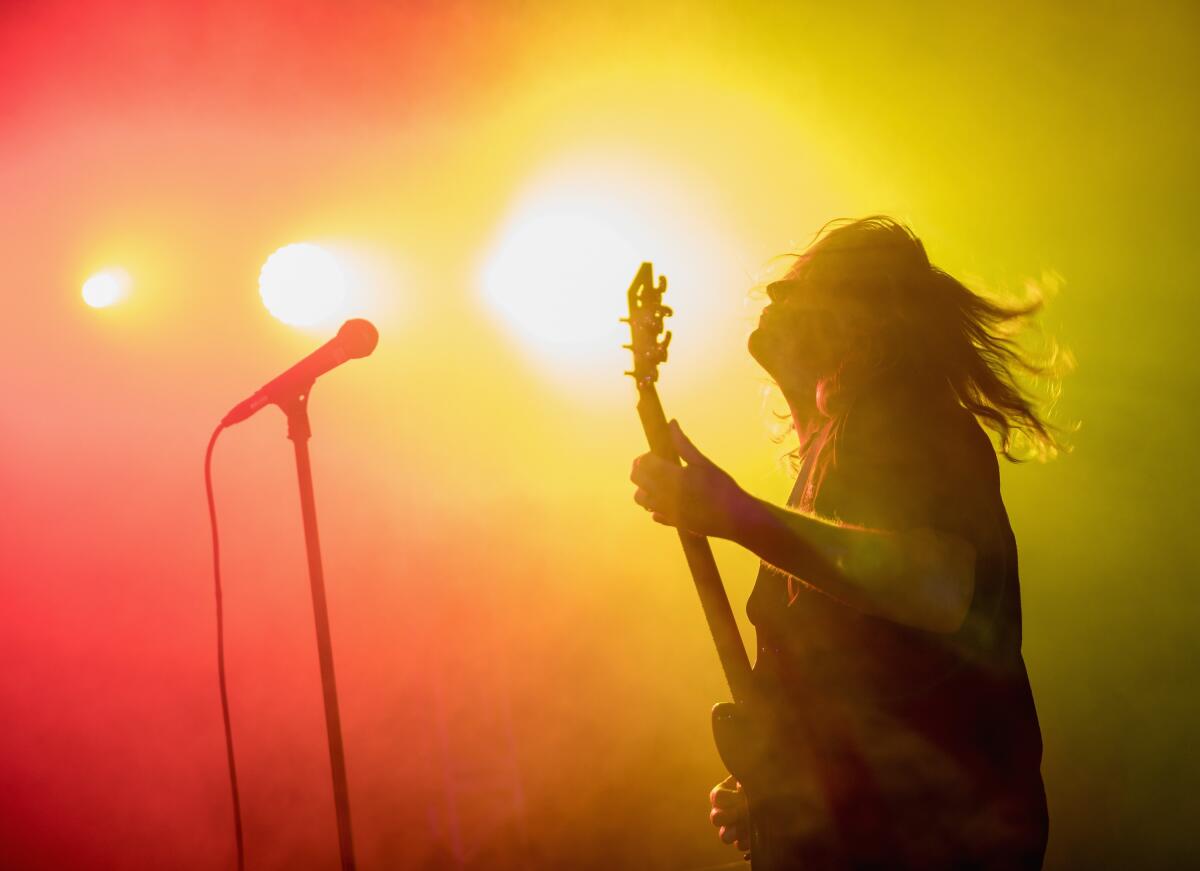Inside rocker Ty Segallâs two-month L.A. residency: âThis is too crazy to workâ

Concert residencies usually bring to mind one of two things: veteran-megastar spectacles on the Las Vegas Strip or young upstarts filling weeknight voids at local venues.
Less typical is someone like garage-punk polymath Ty Segall, who last week kicked off a residency at downtown L.A.âs Teragram Ballroom, running Fridays through Sept. 27. Joined by his current touring ensemble, Freedom Band, the 32-year-old Segall will perform two albums in full each night, spotlighting his forthcoming 12th studio album, âFirst Tasteâ (due out Aug. 2 via Drag City), plus a rotating selection of fan favorites and more personal deep cuts.
Over his prolific, decade-long career, Segall has proved to be a torchbearer of California rock, veering from surf garage to frenetic hardcore to desert-hewn psychedelia, in a lane all his own. Between his relentless touring and prodigious recording output â as both a solo artist and in collaboration with such acts as White Fence and Mikal Cronin â keeping up with his music has become something of an in-joke among fans.
The Teragram sets, which clock in around two hours, elevate his often ramshackle rock show with theatrical flourishes such as thematic lighting schemes and a giant mask centerpiece dubbed âSalad Head.â
We caught up with Segall at his home in Topanga Canyon to discuss the pros and cons of staying put, his love of masks, and the experience of relearning nearly 80 songs.
Youâve played multi-night stints in L.A. and other cities before. What led you to want to do a more extended run?
Selfishly, I wanted to do a residency in L.A. as a way to stay home for the summer, and that led to wanting to do different albums and really go crazy. I hadnât ever played so-and-so album in its entirety, so it seemed like a good excuse. The Teragram is also my favorite place to play in town. Itâs like our second home. So that was a no-brainer.
What has been your process to prepare?
We practiced for 2½ months straight and learned all the albums. âCause itâs almost 80 songs. And a quarter of the songs have never been played live, ever. So itâs super fun to tweak. Like, a second chance to change the songs, maybe fix something you donât really like about them, or reinterpret them.
Given your extensive catalog, how did you end up choosing the albums you did for the run?
Half the choice is a selfish one for me, wanting to play what Iâd want to play. And then the other half is thinking about what my fans would want to hear. âGoodbye Breadâ and âEmotional Muggerâ are just some of my personal favorite albums that Iâve made, and theyâre not by any means the most popular ones. âMeltedâ and âManipulatorâ â those seem to be the fan favorites. So we shaped it to be a little bit of both.
Are there any acts who have done or are doing something similar that influenced your approach to a residency?
Iâd like to think Iâm hugely influenced by Elvisâ Las Vegas residency vibe. [Laughs] No, I donât know. Honestly, we were all like, this is too crazy to work. Thereâs no way we could pull this off. But Teragram was really supportive, and we thought, well, if they think we can do it, then letâs give it a shot. As far as live acts I admire, the freeness of the Dead is a big influence for me. And in the same way, the controlled freeness of Fela Kuti. The nasty insanity of a Black Flag show. Neil Young, Funkadelic â these extravagant, amazing things.
Do you think this is a model that other acts could adapt? What are some of the challenges of doing a residency like this?
The obvious challenge is that itâs in one city. You have to get almost 7,000 people to come see you play in one city. But itâs over 2½ months. And there are a lot of people who have bought tickets for multiple shows. Itâs an experiment.
Creatively, how do you approach this?
We want it to be special. We didnât want to just show up with our gear and walk on with jeans and just play the songs. Especially with the new album, I wanted it to be drastically different-looking than when we play the old albums â up-lit versus down-lit, red versus blue, a heavier mood. I wanted there to be multiple parts of the set, and have it be pretty obvious. Then the giant head mask â Salad Head â heâs the new mascot of the whole summer experience.
I have a long-going obsession with the idea of a mask and performance, and oneâs ability to make a persona, make a character. A lot of my records have different faces on them, and a lot of the albums have different personas or characters. So Salad Head is another one but in a large-scale representation.
What have you learned about yourself by coming back to those older songs?
Iâve become far more prog as a musician over the years. A lot of my songs now donât stick to the verse-chorus-verse-chorus-bridge-chorus structure. I was in a little bit of a box for a couple of years there. But I was like 21 and emotionally just a child. My priorities were completely different. On âMelted,â for example, theyâre raging party songs, but there are some existential vibes in there. âGoodbye Breadâ is where I got heavy, lyrically and vibe-wise. Itâs interesting. Weâre all just different times.
Ty Segall and Freedom Band performing âFirst Tasteâ and âMelted.â $30. Teragram Ballroom, 1234 W. 7th St., 9 p.m. Friday.
More to Read
The biggest entertainment stories
Get our big stories about Hollywood, film, television, music, arts, culture and more right in your inbox as soon as they publish.
You may occasionally receive promotional content from the Los Angeles Times.










